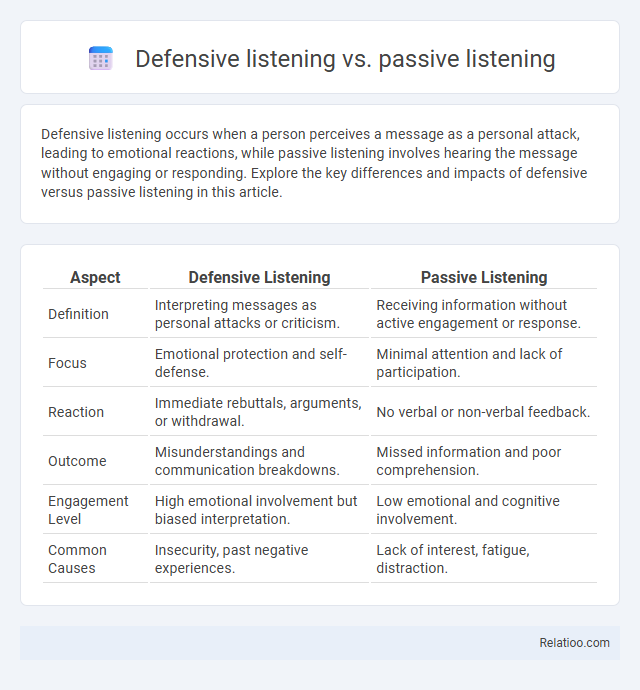Defensive listening occurs when a person perceives a message as a personal attack, leading to emotional reactions, while passive listening involves hearing the message without engaging or responding. Explore the key differences and impacts of defensive versus passive listening in this article.
Table of Comparison
| Aspect | Defensive Listening | Passive Listening |
|---|---|---|
| Definition | Interpreting messages as personal attacks or criticism. | Receiving information without active engagement or response. |
| Focus | Emotional protection and self-defense. | Minimal attention and lack of participation. |
| Reaction | Immediate rebuttals, arguments, or withdrawal. | No verbal or non-verbal feedback. |
| Outcome | Misunderstandings and communication breakdowns. | Missed information and poor comprehension. |
| Engagement Level | High emotional involvement but biased interpretation. | Low emotional and cognitive involvement. |
| Common Causes | Insecurity, past negative experiences. | Lack of interest, fatigue, distraction. |
Understanding Defensive Listening
Defensive listening occurs when a listener perceives a speaker's message as a personal attack or criticism, leading to emotional reactions that hinder effective communication. Unlike passive listening, where the listener remains disengaged and absorbs information without active processing, defensive listening triggers heightened sensitivity and mistrust. Understanding defensive listening requires recognizing its impact on interpersonal dynamics and developing strategies such as mindfulness and empathy to reduce misinterpretations and improve dialogue quality.
Defining Passive Listening
Passive listening involves receiving messages without actively engaging or responding, often resulting in missed details or misunderstandings. Defensive listening occurs when you interpret comments as personal attacks, leading to emotional responses rather than objective understanding. In contrast, active listening requires focused attention and feedback to ensure clear communication and mutual comprehension.
Key Differences between Defensive and Passive Listening
Defensive listening occurs when the listener perceives a message as a personal attack or criticism, often reacting with hostility or self-protection, while passive listening involves hearing the message without actively engaging or responding. Key differences include the level of emotional response and engagement; defensive listeners are emotionally reactive and may interrupt or argue, whereas passive listeners remain detached and fail to provide feedback or clarification. Both types hinder effective communication, but defensive listening distorts the intended message due to sensitivity, whereas passive listening results in missed information and lack of understanding.
Causes of Defensive Listening
Defensive listening occurs when a listener perceives comments as personal attacks, often caused by low self-esteem, past experiences, or a strong emotional investment in the topic. Passive listening involves minimal engagement and processing of information, leading to misunderstandings and lack of response. Unlike passive or active listening, defensive listening is triggered by sensitivity to criticism, resulting in misinterpretation and strained communication.
Common Triggers for Passive Listening
Common triggers for passive listening often include distractions, lack of interest, and information overload, causing the listener to receive messages without active engagement or response. In contrast, defensive listening is characterized by interpreting messages as personal attacks or criticism, leading to emotional responses, while active listening involves fully concentrating and responding thoughtfully to the speaker. Recognizing these triggers helps improve communication effectiveness by encouraging more attentive and open forms of listening.
Effects of Defensive Listening in Communication
Defensive listening often leads to misunderstandings and conflict as individuals perceive messages as personal attacks, hindering effective communication and collaboration. This behavior increases stress and reduces openness, causing listeners to miss critical information or misinterpret intentions. In contrast, passive listening results in disengagement and lack of feedback, while active listening promotes understanding and constructive dialogue.
Consequences of Passive Listening in Relationships
Passive listening often leads to misunderstandings and unresolved conflicts in relationships because key emotional cues and concerns are overlooked. Your partner may feel unheard and undervalued, which can erode trust and intimacy over time. Unlike defensive listening, which triggers confrontation, or attentive listening, passive listening allows issues to fester, weakening emotional connection and communication effectiveness.
Strategies to Overcome Defensive Listening
Defensive listening occurs when you perceive messages as personal attacks, often leading to misunderstandings, whereas passive listening involves minimal engagement without feedback, and active listening strictly focuses on understanding the speaker's intent. To overcome defensive listening, strategies such as maintaining an open mind, asking clarifying questions, and managing emotional responses effectively can help transform communication into a more constructive dialogue. Enhancing your listening skills by practicing empathy and focusing on the message rather than perceived judgments significantly reduces defensive reactions.
Techniques to Move Beyond Passive Listening
Effective communication requires distinguishing between defensive listening, passive listening, and active engagement. Techniques to move beyond passive listening include focusing intently on the speaker's message, asking clarifying questions to ensure understanding, and providing feedback that reflects your interpretation. By adopting these strategies, you can enhance your communication skills and reduce misunderstandings rooted in defensive or inattentive listening.
Building Effective Listening Skills
Building effective listening skills involves distinguishing between defensive listening, passive listening, and active listening for better communication outcomes. Defensive listening occurs when a listener perceives remarks as personal attacks, hindering understanding and escalating conflicts. Passive listening lacks engagement or feedback, reducing information retention, while active listening promotes empathy and clarity by fully focusing and responding thoughtfully to the speaker.

Infographic: Defensive listening vs Passive listening
 relatioo.com
relatioo.com